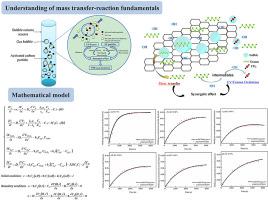Chemosphere ( IF 8.8 ) Pub Date : 2021-06-08 , DOI: 10.1016/j.chemosphere.2021.131021 Haiying Chen 1 , Jiemin Liu 2 , Chuandong Wu 2 , Tongwang Zhang 3

|
Volatile organic compounds (VOCs) emissions are regarded as a worth concerned threat to human health. The UV-Fenton coupled with mass transfer enhanced process shows promising effects on VOCs treatment. However, the detailed mechanism and mathematical model for this method have not been established. This work focuses on the hypothesis and validation of a mathematical model for UV-Fenton removal of VOCs using activated carbon particles to enhance mass transfer efficiency. Based on the mathematical model of reaction-diffusion-mass transfer, a mathematical model is established by using a series of important parameters such as ub, Dg, Dl, Kial, Kla and hydroxyl radical lifetime. The proposed model in this study introduces the key parameter of synergistic factor, which greatly improves the consistency between the model predicted results and the experimental data (the determination coefficient R2 distribution range changed from 0.71–0.98 to 0.95–0.98). Moreover, it can also explain reasonably the steady trend of outlet VOC concentration after 30 min of reaction. The mathematical model confirms that the addition of activated carbon during the UV-Fenton reaction ensures mass transfer efficiency and considerably improves (growth from 2% to 54%) the VOCs removal efficiency due to the synergy between UV-Fenton oxidation and mass transfer enhancement. Meanwhile, it provides insight into fruitful utilization of the oxidation capacity in the oxidation reaction,and achieves the purpose of predicting the efficiency of VOC removal in the Fenton process.
中文翻译:

用于分析 UV-Fenton 去除 VOC 过程中氧化和传质增强协同效应的综合数学模型
挥发性有机化合物 (VOC) 排放被视为对人类健康的一个值得关注的威胁。UV-Fenton 结合传质增强过程显示出对 VOC 处理的有希望的效果。然而,该方法的详细机理和数学模型尚未建立。这项工作的重点是使用活性炭颗粒提高传质效率的 UV-Fenton 去除 VOC 的数学模型的假设和验证。在反应-扩散-传质数学模型的基础上,利用u b、D g、D l、K ial、K l等一系列重要参数建立了数学模型。a 和羟基自由基寿命。本研究提出的模型引入了协同因子这一关键参数,极大地提高了模型预测结果与实验数据(决定系数R 2分布范围从 0.71-0.98 变为 0.95-0.98)。此外,它还可以合理解释反应30分钟后出口VOC浓度的稳定趋势。数学模型证实,由于 UV-Fenton 氧化和传质增强之间的协同作用,在 UV-Fenton 反应过程中添加活性炭可确保传质效率并显着提高(从 2% 增长到 54%)VOC 去除效率。同时,它提供了对氧化反应中氧化能力的有效利用的洞察,达到了预测Fenton过程中VOC去除效率的目的。


























 京公网安备 11010802027423号
京公网安备 11010802027423号